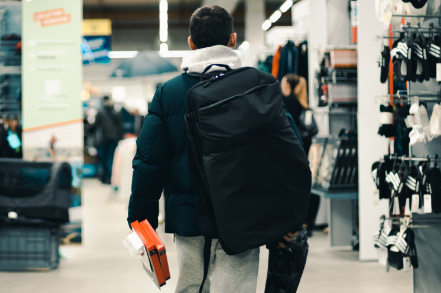Combatting Organized Retail Crime
Organized Retail Crime (ORC) has been a concern for decades, but has recently become an urgent issue gaining national attention. According to a report from the National Retail Federation (NRF), this threat to retailers has quickly grown in scope and complexity. Organized groups have been targeting everyday consumer items that are easier to resell online and come with lower punitive consequences. Online marketplaces have become convenient channels for resale, where consumers purchase them without knowing illegal activity was involved.
Retailers are taking action to upgrade video surveillance and other security measures while industry organizations push for federal policy reform.
Organized Retail Crime Escalates
During the pandemic, these criminal operations grew in prevalence. Perpetrators became bolder and more confident. The 2022 National Retail Security Survey found that “retailers, on average, saw a 26.5% increase in ORC incidents in 2021.” And more disturbing, 80% of retailers reported “violence and aggression associated with ORC incidents increased in the past year.”

While the conversation often focuses on the impact ORC has to companies’ profits and inventory, the increased likelihood of violence in ORC incidents is making it an issue of public safety. Video surveillance examples of these violent acts, even leading to employee death in some cases, have propelled this issue to one of critical importance.
In their written statement to Congress on the impact of ORC, the NRF said, “Retailers’ foremost concern with ORC activity is the safety of retail workers and their customers.” Lenient laws are being exploited to a dangerous level. Policy reform is needed. Through recent hearings and campaign efforts, the NRF has been urging Congress to pass laws that combat this disturbing problem more effectively.
Increased ORC Violence Demands Attention
Congress is taking action. One new bill that went into effect June 27 is the INFORM Act. This legislation requires online marketplaces to collect more information about third-party sellers, and to provide their information to law enforcement officials. This will improve transparency for investigation purposes and inhibit the resale of stolen items in those arenas.
Investigating ORC cases typically involves multiple states and agencies, as the criminal organizations are able to operate for some time before anything can be done about it. The NRF’s report, Organized Retail Crime: An Assessment of a Persistent and Growing Threat, found that “The median ORC fencing operation handled about $250,000 in stolen merchandise prior to being apprehended by law enforcement.” The scope of these operations indicates a need for improved law enforcement coordination.

A new bill currently under consideration in Congress is the Combatting Organized Retail Crime
Act, which would create a center for coordinating national and international information sharing across agencies. This would improve investigations and reduce the time it takes to build a case against perpetrators. Understanding ORC operational patterns requires better data and centralized information.
Retail Companies Increase Security Budgets
With improved legislation underway, retail surveillance is an important tool in preventing and prosecuting these crimes. Being able to provide more detailed, more accurate information to law enforcement is a high priority. In June the NRF stated, “Retailers are devoting considerable resources to prevent the victimization of their employees, guests and organizations. They are boosting their budgets for loss prevention and technology.”
The more information retailers can supply law enforcement with, the more effective law enforcement investigations will be in apprehending the criminals involved. While pushing for reformed policies, retailers are taking initiatives with their preventative efforts by upgrading their security systems.
Upgrading Retail Security Systems with Your Clients
What are some of the security system upgrades retailers are implementing?
- Video monitoring, such as high resolution cameras and analytics, are becoming necessary
tools. - Access control upgrades limit traffic in targeted areas.
- Internet of Things (IoT) inventory with electronic devices are easily tracked and monitored to reduce risk and improve chances of recovery.
This is a relevant time to review our new video solutions with your retail clients to discuss enhancing their security systems.
- V-6000 Series Cameras represent significant advancement in NDAA-compliant, high resolution video technology. Hardwired cameras incorporate video analytics, including line crossing, person or vehicle detection. Learn more.
- XV-24 with AlarmVision® transforms existing cameras into smart motion detectors. Integrate cameras, analytics and XR Series control panels in one platform. Monitor Real Events in Real Time with a Real Response. Learn more.
- 1119 Door Sounder delivers 100dB to 110dB of local annunciation when someone runs out an emergency exit door with shoplifted items.
- 1136 Remote Chime alerts employees when doors open so they can exercise awareness as customers move about the store.
Increasing video monitoring in key areas helps retailers deter criminals. Video analytics gives your clients the ability to respond to critical events rapidly, while diminishing the need to have personnel in harm’s way. These enhanced technologies, along with improved legislation, will make an impact in reducing organized retail crime.
Contact Jim Hawthorne, director of retail solutions, to discuss in more detail.
Want to read more content like this?
With new articles posted every two weeks, you are sure to find articles and content that will help identify industry trends, new products and helpful business tips.

